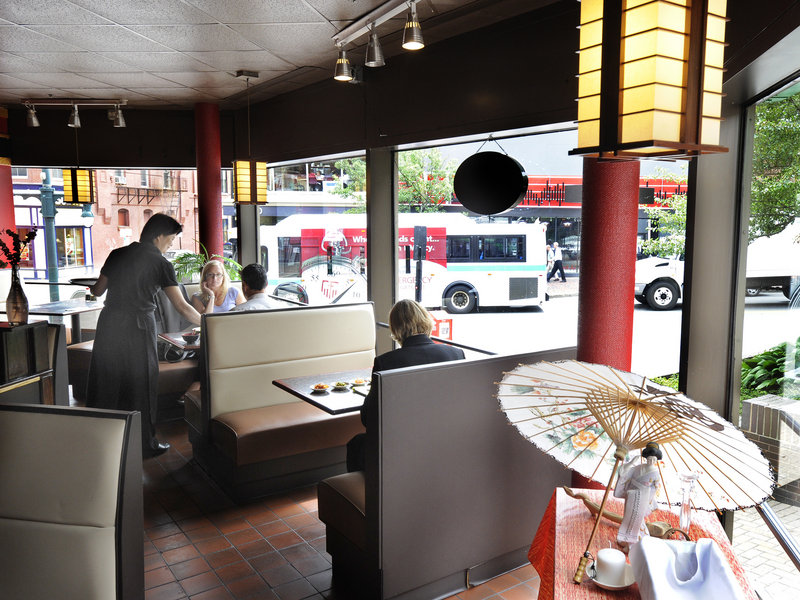Inexpensive Korean and Japanese specialties served at Soju have a lot of things going for them. But given the spaciousness of this restaurant and the crowded Asian restaurant scene in Portland, Soju faces an uphill battle to pull in customers.
And yet, some of us won’t mind its quiet surroundings while the rest of the world is still deciding whether or not to give it a try.
We might also taste soju itself, a kind of liquor made with rice that tastes like vodka.
Korean dishes are such a good fit for Maine weather, with their spicy and sour flavors, that Soju should be on the list of places for lunch and dinner just so you can enjoy that cuisine more often.
The restaurant’s kimchi bokum showcased a spicy but not-too-hot red chili sauce, crunchy bok choy with saut? pork, and mild, raw tofu, a meal custom-made for any kind of cool weather.
Sushi and sashimi have managed to win such wide popularity that Portland supports more than half a dozen sushi spots, several of which are excellent at what they do.
Again, Soju has its work cut out for itself to make an impression and rope in fans of other spots already blessed with dedicated customers.
Inventive maki or rolls are one campaign tool, and Soju’s Maine Roll, with lobster, asparagus, lettuce and avocado topped with tobiko ($12), argues maki’s potential superiority over the far more familiar Maine lobster roll.
The Soju roll with Maine crab and avocado wrapped in slices of salmon sounds tempting indeed.
But on our visit, we concentrated on cooked dishes among both Japanese and Korean offerings.
A little bottle of Kekkeikan Zipang ($9) contained sparkling sake, which was simple and, while cold, completely refreshing. The bottle label says it’s naturally carbonated, but there is nothing complex about this rice wine. Several other sake wines, as well as familiar best-selling wines and a decent selection of beer, are also served.
Big and comfortable booths make a relaxing perch to watch passersby on Congress Street.
We started off with pork gyoza ($5.25), which had been made with a wrapper that was perfectly tailored. The Japanese take on dumplings, these gyoza featured thin and delicate dough nicely pleated around a filling of pork and vegetables jazzed up with ginger. The thin, savory dipping sauce enhanced the dumplings’ savory taste.
Beef negimaki ($6.50) is a concept that faltered in its realization. Its thinly sliced rib eye steak, wrapped around scallions and covered in teriyaki sauce, sounded excellent, with savory saut? scallions from an excellent Chinese restaurant in New York, and rib-eye steak from all over edged with a bit of crunchy, browned fat.
Perhaps this would work in smaller bundles, but Soju’s version errs with a beefy wrapping that was too thick and chewy, and a sauce that was too salty.
Five saucers of kim chee (pickled vegetables) accompanied our Korean order, and included traditional pickled cabbage with crunchy and spicy red chili sauce, along with freshly pickled slices of cucumber, skinny sticks of lightly cooked potato dressed in vinegar, similar florets of broccoli, and a saucer of chewy, slightly fishy tofu that seemed to have been fried.
The flavors of those fresh pickled condiments made the right introduction to kimchi bokum ($8.50), a generous heap of wide chunks of bok choy saut? with red chili sauce and interwoven with slices of tender, savory pork.
Several rectangular slices of pure white tofu lay against one side of the meal, ready to present its mild, pure taste in contrast to the spicy sauce, like an Asian version of plain ice or sorbet you sometimes get in fancier restaurants to cleanse the palate.
Slices of rice cake were gluttonous and chewy, and mixed in with the cabbage. Although I have become a fan of mochi ice cream surrounded with sweetened rice-flour dough, these thick rice-flour cakes didn’t appeal to me.
Yaki udon ($8.50) held big, fat, square rice noodles — again not a favorite, but well-liked by my dinner companion. The mild sauce and scallions, zucchini, carrots, onions and mushrooms mixed with cubes of tofu that had a crisp, thin fried coating kept the dish interesting.
Chocolate fondue came up as a choice for dessert because we were not interested in fried ice cream or cheesecake, and because plain ice cream was not available.
But chocolate fondue isn’t worth ordering at Soju, where the stuff is super sweet — likely ladled out of a jar.
And the tired strawberries, canned pineapple, salty pretzel sticks and frozen cheesecake that you can dip in it don’t taste good either on their own or bathed in that particular chocolate.
N.L. English is a Portland freelance writer. Visit English’s Web site, www.chowmaineguide.com.
Send questions/comments to the editors.



Success. Please wait for the page to reload. If the page does not reload within 5 seconds, please refresh the page.
Enter your email and password to access comments.
Hi, to comment on stories you must . This profile is in addition to your subscription and website login.
Already have a commenting profile? .
Invalid username/password.
Please check your email to confirm and complete your registration.
Only subscribers are eligible to post comments. Please subscribe or login first for digital access. Here’s why.
Use the form below to reset your password. When you've submitted your account email, we will send an email with a reset code.